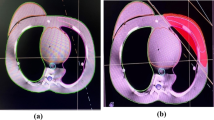Abstract
Leakage radiation from linear accelerators can make a significant contribution to healthy tissue dose in patients undergoing radiotherapy. In this work thermoluminescent dosimeters (LiF:Mg,Cu,P TLD chips) were used in a focused lead cone loaded with TLD chips for the purpose of evaluating leakage dose at the patient plane. By placing the TLDs at one end of a stereotactic cone, a focused measurement device is created; this was tested both in and out of the primary beam of a Varian 21-iX linac using 6 MV photons. Acrylic build up material of 1.2 cm thickness was used inside the cone and measurements made with either one or three TLD chips at a given distance from the target. Comparing the readings of three dosimeters in one plane inside the cone offered information regarding the orientation of the cone relative to a radiation source. Measurements in the patient plane with the linac gantry at various angles demonstrated that leakage dose was approximately 0.01 % of the primary beam out of field when the cone was pointed directly towards the target and 0.0025 % elsewhere (due to scatter within the gantry). No specific ‘hot spots’ (e.g., insufficient shielding or gaps at abutments) were observed. Focused cone measurements facilitate leakage dose measurements from the linac head directly at the patient plane and allow one to infer the fraction of leakage due to ‘direct’ photons (along the ray-path from the bremsstrahlung target) and that due to scattered photons.









Similar content being viewed by others
References
Xu XG, Bednarz B, Paganetti H et al (2008) A review of dosimetry studies on external-beam radiation treatment with respect to cancer induction. Phys Med Biol 53:R193–R241
Taylor ML et al (2010) Stereotactic fields shaped with a micro-multileaf collimator: systematic characterization of peripheral dose. Phys Med Biol 55:873
Jaradat AK, Biggs PJ (2007) Measurement of the leakage radiation from linear accelerators in the backward direction for 4, 6, 10, 15 and 18 MV X-ray energies. Health Phys 92(4):387–395
Taylor ML, Kron T (2011) Consideration of the radiation dose delivered away from the treatment field to patients in radiotherapy. J Med Phys 36(2):59–71
Taylor ML, Kron T, Franich RD (2011) Assessment of out-of-field doses in radiotherapy of brain lesions in children. Int J Radiat Oncol Biol Phys 79(3):927–933
Chofor N, Harder D, Willborn KC, Poppe B (2012) Internal scatter, the unavoidable major component of the peripheral dose in photon-beam radiotherapy. Phys Med Biol 57(6):1733–1743
Fraass BA, van de Geijn J (1983) Peripheral dose from megavolt beams. Med Phys 10(6):809–818
Benadjaoud M et al (2012) A multi-plane source model for out-of-field head scatter dose calculations in external beam photon therapy. Phys Med Biol 57(22):7725–7739
Chofor N, Harder D, Rühmann A, Willborn KC, Wiezorek T, Poppe B (2010) Experimental study on photon-beam peripheral doses, their components and some possibilities for their reduction. Phys Med Biol 55(14):4011–4027
Cashmore J (2008) The characterisation of unflattened photon beams from a 6 MV linear accelerator. Phys Med Biol 53(7):1933–1946
Kase KR, Svensson GK, Wolbarst AB, Marks MA (1983) Measurement of dose from secondary radiation outside a treatment field. Int J Radiat Oncol Biol Phys 9(8):1173–1183
Lonski P, Taylor ML, Kron T, Franich RD (2012) Assessment of leakage dose around the treatment heads of different linear accelerators. Rad Prot Dosim 152(4):304–312
Kron T (1994) Thermoluminescence dosimetry and its applications in medicine.Part 1: physics, materials and equipment. Australas Phys Eng Sci Med 17(4):175–199
Kron T et al (1998) Dose response of various radiation detectors to synchrotron radiation. Phys Med Biol 43(11):3235–3259
National Council on Radiation Protection and Measurements (NCRP) (2005) Structural shielding design and evaluation for x- and gamma ray radiotherapy facilities. Report No. 151
International Electrotechnical Commission (IEC) (1981) Safety of medical electrical equipment, Part 2: particular requirements for medical electron accelerators in the range 1–50 MeV, Publication 601-2-1. IEC, Geneva
International Atomic Energy Agency (IAEA) (2006) Radiation protection in the design of radiotherapy facilities. Safety Report Series no. 47:23–25
Acknowledgments
This work is supported by National Health and Medical Research Council (NHMRC, Australia) Project Grant 555240. We would also like to thank Ryan Smith (WBRC Alfred Hospital and RMIT University) for his assistance.
Author information
Authors and Affiliations
Corresponding author
Rights and permissions
About this article
Cite this article
Lonski, P., Taylor, M.L., Franich, R.D. et al. A collimated detection system for assessing leakage dose from medical linear accelerators at the patient plane. Australas Phys Eng Sci Med 37, 15–23 (2014). https://doi.org/10.1007/s13246-013-0235-8
Received:
Accepted:
Published:
Issue Date:
DOI: https://doi.org/10.1007/s13246-013-0235-8




